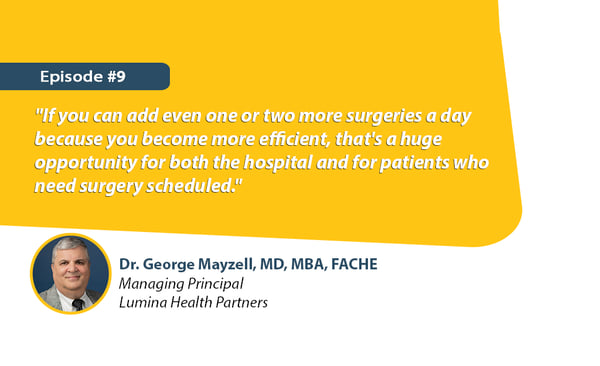Episode Overview:
As part of VBCI’s ongoing coverage of clinical variation reduction (CVR), Episode 9 “How to Start CVR,” focuses on proven approaches for integrating the concept to an organization’s operations.
Lumina Health Partners Principal George Mayzell MD, MBA, FACHE joins co-hosts Daniel J. Marino and Shaillee Chopra to share an effective two-pronged approach that relies on strong physician engagement and adapting organizational infrastructure to support needed changes.
Dr. Mayzell notes that in most cases, organizations that successfully implement CVR initiatives gain early buy-in from physicians who are in formal or informal leadership roles. Physician involvement helps shape new processes and promote new approaches since they had a voice in formulating them.
Co-hosts:

Daniel J. Marino, Managing Partner, Lumina Health Partners

Shaillee Chopra, Principal, Lumina Health Partners
Guest:

George Mayzell, MD, MBA, FACHE, Managing Principal, Lumina Health Partners
Episode Discussion Areas:
1. Engaging Physicians
- How do we engage the physicians within the organization to really drive the change?
- What aspects must be in place, and how do we align incentives?
2. Infrastructure
- What infrastructure is required for success?
- Process and efficiencies
- Physician support
- Data and information (How to track it and align incentives)

10 Key Takeaways: Success Factors of Clinical Variation Reduction
1. Convince senior leadership and physician groups of the importance of CVR.
-
Share economic data from inside the hospital or hospital system and create a burning platform on the importance of efficiencies of care. Remind everyone (CVR) is about financial stewardship as well as creating better outcomes.
2. Engage physicians with data that supports CVR opportunities and enlist them in change management.
Data can help answer questions such as:
- “Who should get surgery?”
- “How do we decide which patients?”
- “How do we decide the right setting (inpatient and outpatient)?”
3. Information you share with physicians must be in a usable format.
- At some point, you want to get down to the actual cost of things. What does it cost for each (surgical) pack that goes to the operating room (OR)? What does it cost for prolonged turnover time? Sharing this information in an understandable format for physicians to impact change is key.
4. Involve physicians early and give them information.
- There are a lot of assumptions that physicians understand hospitals, finances, hospital flow and other resource utilization, but they may not. They will need to be involved early and understand the information in order to provide meaningful feedback.
5. Focus on working with physicians to improve their processes.
- Physicians who reduce inefficiencies in their processes can remove up to 40 or 50 percent of unnecessary costs from their health systems.
6. For physicians, frame CVR as an opportunity to gain time.
- Physicians will be able to handle more cases during the day if you can get on-time starts to work better, if you can make sure the right packs and surgical tools are in the OR at the right time.
7. Peer dialogue among surgeons is invaluable.
- Surgeons learn from each other and by creating this culture, you will build a synergistic model where the physicians are engaged and involved with hospital staff to solve problems.
8. Look closely at costs of diagnosis-related groups (DRGs).
- Surgical DRGs may present a large variation in cost between different providers conducting the same procedure. This provides insight into and can reflect different processes between surgeons and perioperative services.
9. Perioperative services present a huge opportunity for reducing CVR.
- Sometimes just a little bit of change can go a long way. Perioperative services are both a major driver of revenue and a sticking point for hospitals. A popular early step to CVR in these services is look at the different processes that go into surgical decisions and operations.
10. Care-management related areas to look for CVR include:
-
- Pre-op planning and pre-op testing. How do you get anesthesiologists and surgeons to agree? Cancellations are very costly for the hospital, but also for patients, especially last-minute cancellations.
- Starting times. How do you start on time, every time? Consider room turnover and transitions, post-op space discharge, follow up, and transporting of the patient to and from all locations.
Resources mentioned:
About Value-Based Care Insights Podcast
Value-Based Care Insights is a podcast that explores how to optimize the performance of programs to meet the demands of an increasing value-based care payment environment. Hosted by Dan Marino and Shaillee Chopra, the VBCI podcast highlights recognized experts in the field and within Lumina Health Partners.





Share this: